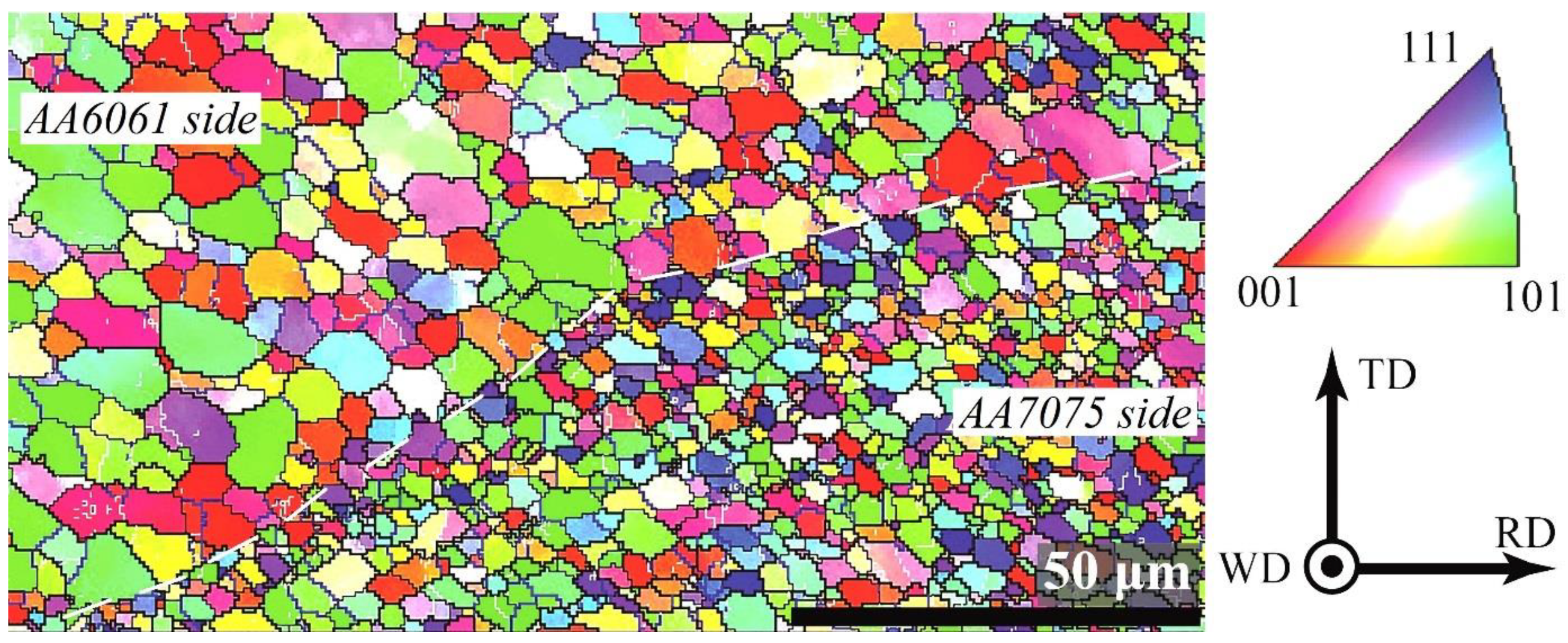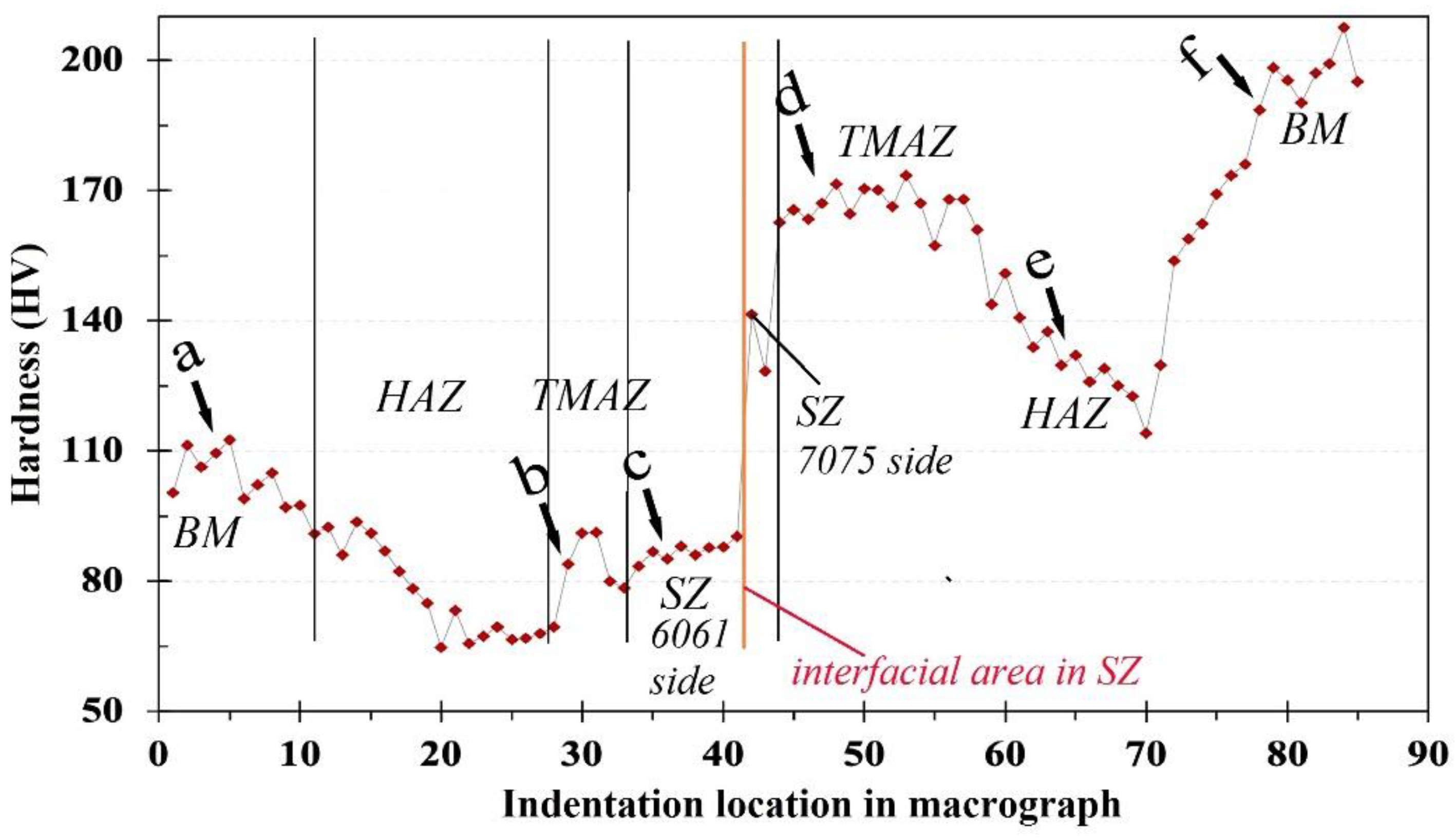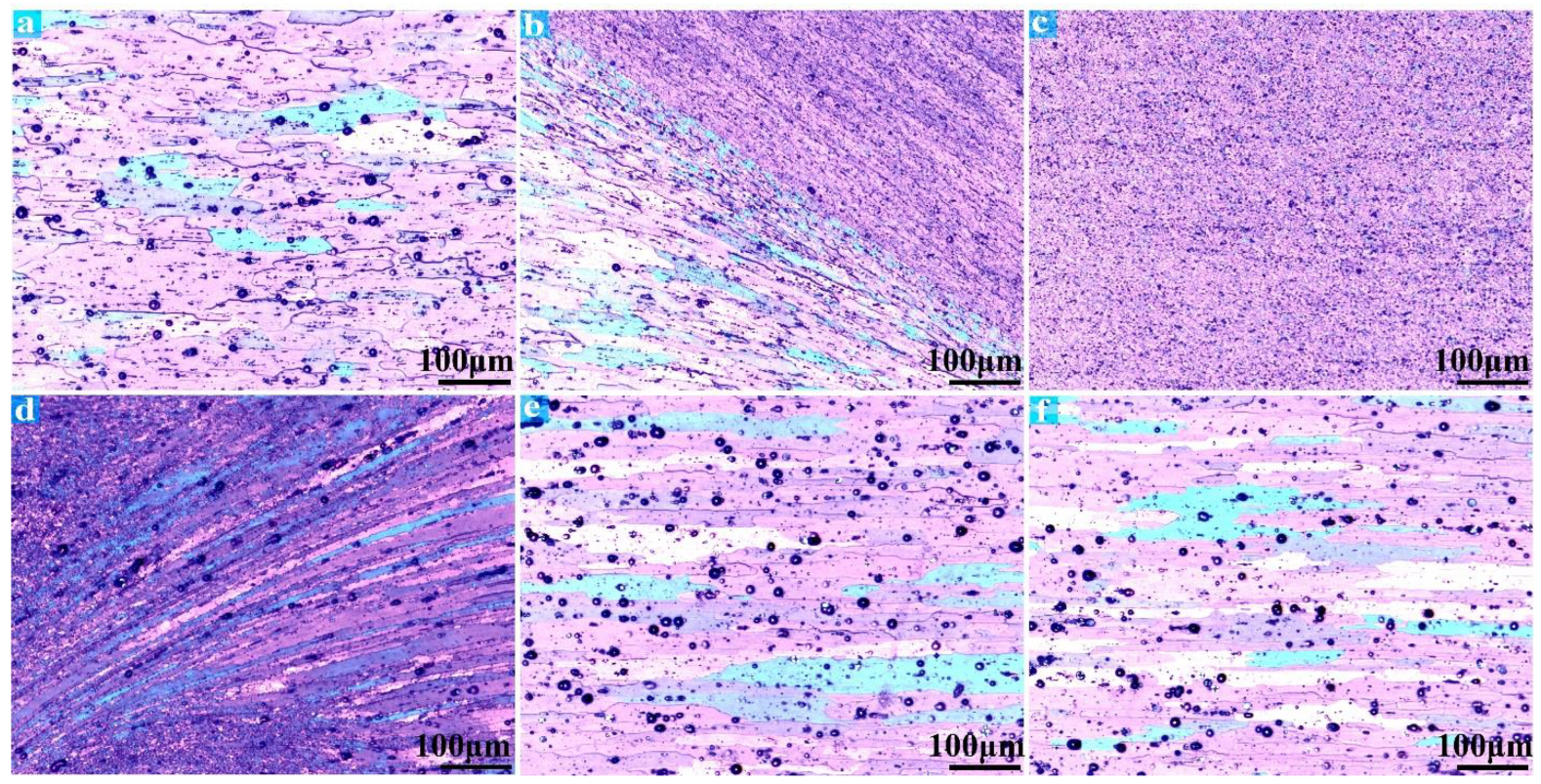Submerged Dissimilar Friction Stir Welding of AA6061 and AA7075 Aluminum Alloys: Microstructure Characterization and Mechanical Property
Abstract
:1. Introduction
2. Materials and Methods
3. Results
4. Discussion
5. Conclusions
Author Contributions
Funding
Acknowledgments
Conflicts of Interest
Nomenclature
| FSW | Friction Stir Welding |
| SZ | Stirred Zone |
| TMAZ | Thermo-Mechanically Affected Zone |
| HAZ | Heat-Affected Zone |
| BMs | Base Metals |
| AS | Advancing Side |
| RS | Retreating Side |
| EBSD | Electron Backscattered Diffraction |
| LBW | Laser Beam Welding |
| OM | Optical Microcopy |
| SEM | Scanning Electron Microscope |
| LABs | Low-Angle Boundaries |
| MABs | Medium-Angle Boundaries |
| HABs | High-Angle Boundaries |
| HV | Vickers Microhardness |
| IPF | Inverse Pole Figure |
| DRV | Dynamic Recovery |
| SFEs | Stacking Fault Energies |
| DRX | Dynamic Recrystallization |
| CDRX | Continuous Dynamic Recrystallization |
| GDRX | Geometrically Dynamic Recrystallization |
| PSN | Particle Stimulated Nucleation |
References
- Meng, X.; Huang, Y.; Cao, J.; Shen, J.; dos Santos, J.F. Recent Progress on Control Strategies for Inherent Issues in Friction Stir Welding. Prog. Mater. Sci. 2021, 115, 100706. [Google Scholar] [CrossRef]
- Paidar, M.; Ojo, O.O.; Moghanian, A.; Karapuzha, A.S.; Heidarzadeh, A. Modified friction stir clinching with protuberance-keyhole levelling: A process for production of welds with high strength. J. Man. Proc. 2019, 41, 177–187. [Google Scholar] [CrossRef]
- Bozkurt, Y.; Salman, S.; Çam, G. Effect of welding parameters on lap shear tensile properties of dissimilar friction stir spot welded AA 5754-H22/2024-T3 joints. Sci. Tech. Weld. Join. 2013, 18, 337–345. [Google Scholar] [CrossRef]
- İpekoğlu, G.; Çam, G. Effects of Initial Temper Condition and Postweld Heat Treatment on the Properties of Dissimilar Friction-Stir-Welded Joints between Aa7075 and Aa6061 Aluminum Alloys. Metall. Mater. Trans. A 2014, 45, 3074–3087. [Google Scholar] [CrossRef]
- Guo, J.F.; Chen, H.C.; Sun, C.N.; Bi, G.; Sun, Z.; Wei, J. Friction Stir Welding of Dissimilar Materials between Aa6061 and Aa7075 Al Alloys Effects of Process Parameters. Mater. Design (1980–2015) 2014, 56, 185–192. [Google Scholar]
- Janeczek, A.; Tomków, J.; Fydrych, D. The Influence of Tool Shape and Process Parameters on the Mechanical Properties of Aw-3004 Aluminium Alloy Friction Stir Welded Joints. Materials 2021, 14, 3244. [Google Scholar] [CrossRef] [PubMed]
- Memon, S.; Tomków, J.; Derazkola, H.A. Thermo-Mechanical Simulation of Underwater Friction Stir Welding of Low Carbon Steel. Materials 2021, 14, 4953. [Google Scholar] [CrossRef] [PubMed]
- Calogero, V.; Costanza, G.; Missori, S.; Tata, M.E. A Weldability Study of Al–Cu–Li 2198 Alloy. Metallurgist 2014, 57, 1134–1141. [Google Scholar] [CrossRef]
- Raturi, M.; Bhattacharya, A. Microstructure and Texture Correlation of Secondary Heating Assisted Dissimilar Friction Stir Welds of Aluminum Alloys. Mater. Sci. Eng. A 2021, 825, 141891. [Google Scholar] [CrossRef]
- Zhang, C.; Huang, G.; Liu, Q. Quantitative Analysis of Grain Structure and Texture Evolution of Dissimilar Aa2024/7075 Joints Manufactured by Friction Stir Welding. Mater. Today Commun. 2021, 26, 101920. [Google Scholar] [CrossRef]
- Raturi, M.; Bhattacharya, A. Mechanical Strength and Corrosion Behavior of Dissimilar Friction Stir Welded Aa7075-Aa2014 Joints. Mater. Chem. Phys. 2021, 262, 124338. [Google Scholar] [CrossRef]
- Niu, P.L.; Li, W.Y.; Chen, D.L. Tensile and Cyclic Deformation Response of Friction-Stir-Welded Dissimilar Aluminum Alloy Joints: Strain Localization Effect. J. Mater. Sci. Technol. 2021, 73, 91–100. [Google Scholar] [CrossRef]
- Zhang, C.; Huang, G.; Liu, Q. Research on Local Corrosion Behavior of Thermo-Mechanically Affected Zone in Dissimilar Aa2024/7075 Friction Stir Welds. Intermetallics 2021, 130, 107081. [Google Scholar] [CrossRef]
- Zhang, C.; Huang, G.; Cao, Y.; Zhu, Y.; Huang, X.; Zhou, Y.; Li, Q.; Zeng, Q.; Liu, Q. Microstructure Evolution of Thermo-Mechanically Affected Zone in Dissimilar Aa2024/7075 Joint Produced by Friction Stir Welding. Vacuum 2020, 179, 109515. [Google Scholar] [CrossRef]
- Zhang, C.; Huang, G.; Cao, Y.; Zhu, Y.; Li, W.; Wang, X.; Liu, Q. Microstructure and Mechanical Properties of Dissimilar Friction Stir Welded Aa2024-7075 Joints: Influence of Joining Material Direction. Mater. Sci. Eng. A 2019, 766, 138368. [Google Scholar] [CrossRef]
- Zhang, C.; Cao, Y.; Huang, G.; Zeng, Q.; Zhu, Y.; Huang, X.; Li, N.; Liu, Q. Influence of Tool Rotational Speed on Local Microstructure, Mechanical and Corrosion Behavior of Dissimilar Aa2024/7075 Joints Fabricated by Friction Stir Welding. J. Manuf. Process. 2020, 49, 214–226. [Google Scholar] [CrossRef]
- Fonda, R.W.; Bingert, J.F.; Colligan, K.J. Development of Grain Structure During Friction Stir Welding. Scr. Mater. 2004, 51, 243–248. [Google Scholar] [CrossRef]
- Shen, C.; Zhang, J.; Ge, J. Microstructures and Electrochemical Behaviors of the Friction Stir Welding Dissimilar Weld. J. Environ. Sci. 2011, 23, S32–S35. [Google Scholar] [CrossRef]
- Srinivasan, P.B.; Dietzel, W.; Zettler, R.; Dos Santos, J.F.; Sivan, V. Effects of Inhibitors on Corrosion Behaviour of Dissimilar Aluminium Alloy Friction Stir Weldment. Corros. Eng. Sci. Technol. 2007, 42, 161–167. [Google Scholar] [CrossRef] [Green Version]
- Niu, P.L.; Li, W.Y.; Vairis, A.; Chen, D.L. Cyclic Deformation Behavior of Friction-Stir-Welded Dissimilar Aa5083-to-Aa2024 Joints: Effect of Microstructure and Loading History. Mater. Sci. Eng. A 2019, 744, 145–153. [Google Scholar] [CrossRef]
- Malikov, A.G.; Orishich, A.M. Laser Welding of the High-Strength Al–Cu–Li Alloy. Int. J. Adv. Manuf. Technol. 2018, 94, 2217–2227. [Google Scholar] [CrossRef]
- Aghajani Derazkola, H.; Eyvazian, A.; Simchi, A. Submerged Friction Stir Welding of Dissimilar Joints between an Al-Mg Alloy and Low Carbon Steel: Thermo-Mechanical Modeling, Microstructural Features, and Mechanical Properties. J. Manuf. Process. 2020, 50, 68–79. [Google Scholar] [CrossRef]
- Luo, X.C.; Zhang, D.T.; Cao, G.H.; Qiu, C.; Chen, D.L. Multi-Pass Submerged Friction Stir Processing of Az61 Magnesium Alloy: Strengthening Mechanisms and Fracture Behavior. J. Mater. Sci. 2019, 54, 8640–8654. [Google Scholar] [CrossRef]
- Eyvazian, A.; Hamouda, A.; Tarlochan, F.; Derazkola, H.A.; Khodabakhshi, F. Simulation and Experimental Study of Underwater Dissimilar Friction-Stir Welding between Aluminium and Steel. J. Mater. Res. Technol. 2020, 9, 3767–3781. [Google Scholar] [CrossRef]
- Tomków, J.; Fydrych, D.; Wilk, K. Effect of Electrode Waterproof Coating on Quality of Underwater Wet Welded Joints. Materials. 2020, 13, 2947. [Google Scholar] [CrossRef]
- Moreno-Uribe, A.M.; Bracarense, A.Q.; Pessoa, E.C.P. The Effect of Polarity and Hydrostatic Pressure on Operational Characteristics of Rutile Electrode in Underwater Welding. Materials 2020, 13, 5001. [Google Scholar] [CrossRef] [PubMed]
- Tomków, J.; Janeczek, A.; Rogalski, G.; Wolski, A. Underwater Local Cavity Welding of S460n Steel. Materials 2020, 13, 5535. [Google Scholar] [CrossRef] [PubMed]
- Tomków, J. Weldability of Underwater Wet-Welded Hsla Steel: Effects of Electrode Hydrophobic Coatings. Materials 2021, 14, 1364. [Google Scholar] [CrossRef] [PubMed]
- Chen, Y.J.; Li, Y.J.; Walmsley, J.C.; Dumoulin, S.; Gireesh, S.S.; Armada, S.; Skaret, P.C.; Roven, H.J. Quantitative Analysis of Grain Refinement in Titanium During Equal Channel Angular Pressing. Scr. Mater. 2011, 64, 904–907. [Google Scholar] [CrossRef]
- Cavaliere, P.; De Santis, A.; Panella, F.; Squillace, A. Effect of Welding Parameters on Mechanical and Microstructural Properties of Dissimilar Aa6082–Aa2024 Joints Produced by Friction Stir Welding. Mater. Des. 2009, 30, 609–616. [Google Scholar] [CrossRef]
- Kalemba-Rec, I.; Kopyściański, M.; Miara, D.; Krasnowski, K. Effect of Process Parameters on Mechanical Properties of Friction Stir Welded Dissimilar 7075-T651 and 5083-H111 Aluminum Alloys. Int. J. Adv. Manuf. Technol. 2018, 97, 2767–2779. [Google Scholar] [CrossRef] [Green Version]
- Jamshidi Aval, H.; Serajzadeh, S.; Kokabi, A.H. Thermo-Mechanical and Microstructural Issues in Dissimilar Friction Stir Welding of Aa5086–Aa6061. J. Mater. Sci. 2011, 46, 3258–3268. [Google Scholar] [CrossRef]
- Dong, J.; Zhang, D.; Luo, X.; Zhang, W.; Zhang, W.; Qiu, C. Ebsd Study of Underwater Friction Stir Welded Aa7003-T4 and Aa6060-T4 Dissimilar Joint. J. Mater. Res. Technol. 2020, 9, 4309–4318. [Google Scholar] [CrossRef]
- Heidarzadeh, A.; Mironov, S.; Kaibyshev, R.; Çam, G.; Simar, A.; Gerlich, A.; Khodabakhshi, F.; Mostafaei, A.; Field, D.P.; Robson, J.D.; et al. Friction Stir Welding/Processing of Metals and Alloys: A Comprehensive Review on Microstructural Evolution. Prog. Mater. Sci. 2020, 117, 100752. [Google Scholar] [CrossRef]
- Mishra, R.S.; Ma, Z.Y. Friction Stir Welding and Processing. Mater. Sci. Eng. R Rep. 2005, 50, 1–78. [Google Scholar] [CrossRef]
- Bay, B.; Hansen, N.; Hughes, D.A.; Kuhlmann-Wilsdorf, D. Overview No. 96 Evolution of F.C.C. Deformation Structures in Polyslip. Acta Metall. Et Mater. 1992, 40, 205–219. [Google Scholar] [CrossRef]
- Hughes, D.A.; Hansen, N. High Angle Boundaries Formed by Grain Subdivision Mechanisms. Acta Mater. 1997, 45, 3871–3886. [Google Scholar] [CrossRef]
- Humphreys, F.J.; Hatherly, M. Recrystallization and Related Phenomena, 2nd ed.; Elsevier: Amsterdam, The Netherlands, 2004. [Google Scholar]






| Alloy | Chemical Composition (wt. %) | Hardness (Hv) | ||||||||
|---|---|---|---|---|---|---|---|---|---|---|
| AA6061 | Mg | Si | Fe | Cu | Cr | Zn | Ti | Mn | Al | 105 |
| 1.01 | 0.62 | 0.35 | 0.24 | 0.17 | 0.12 | 0.12 | 0.07 | Bal. | ||
| AA7075 | Mg | Si | Fe | Cu | Sn | Zn | Ni | Mn | Al | 187 |
| 2.50 | 0.40 | 0.50 | 1.60 | 0.20 | 5.60 | 0.03 | 0.30 | Bal. | ||
Publisher’s Note: MDPI stays neutral with regard to jurisdictional claims in published maps and institutional affiliations. |
© 2021 by the authors. Licensee MDPI, Basel, Switzerland. This article is an open access article distributed under the terms and conditions of the Creative Commons Attribution (CC BY) license (https://creativecommons.org/licenses/by/4.0/).
Share and Cite
Heidarzadeh, A.; Javidani, M.; Mofarrehi, M.; Farzaneh, A.; Chen, X.-G. Submerged Dissimilar Friction Stir Welding of AA6061 and AA7075 Aluminum Alloys: Microstructure Characterization and Mechanical Property. Metals 2021, 11, 1592. https://doi.org/10.3390/met11101592
Heidarzadeh A, Javidani M, Mofarrehi M, Farzaneh A, Chen X-G. Submerged Dissimilar Friction Stir Welding of AA6061 and AA7075 Aluminum Alloys: Microstructure Characterization and Mechanical Property. Metals. 2021; 11(10):1592. https://doi.org/10.3390/met11101592
Chicago/Turabian StyleHeidarzadeh, Akbar, Mousa Javidani, Mohammadreza Mofarrehi, Amir Farzaneh, and X.-Grant Chen. 2021. "Submerged Dissimilar Friction Stir Welding of AA6061 and AA7075 Aluminum Alloys: Microstructure Characterization and Mechanical Property" Metals 11, no. 10: 1592. https://doi.org/10.3390/met11101592







